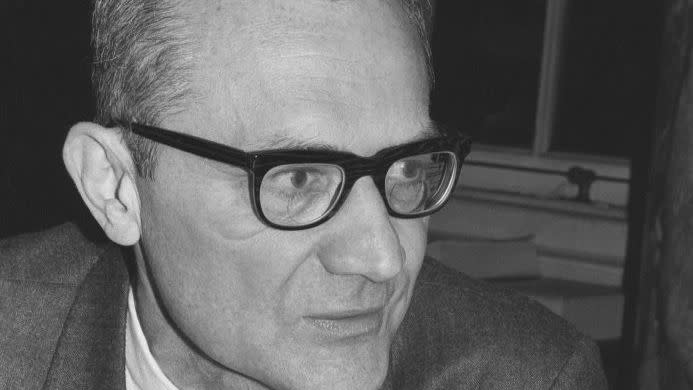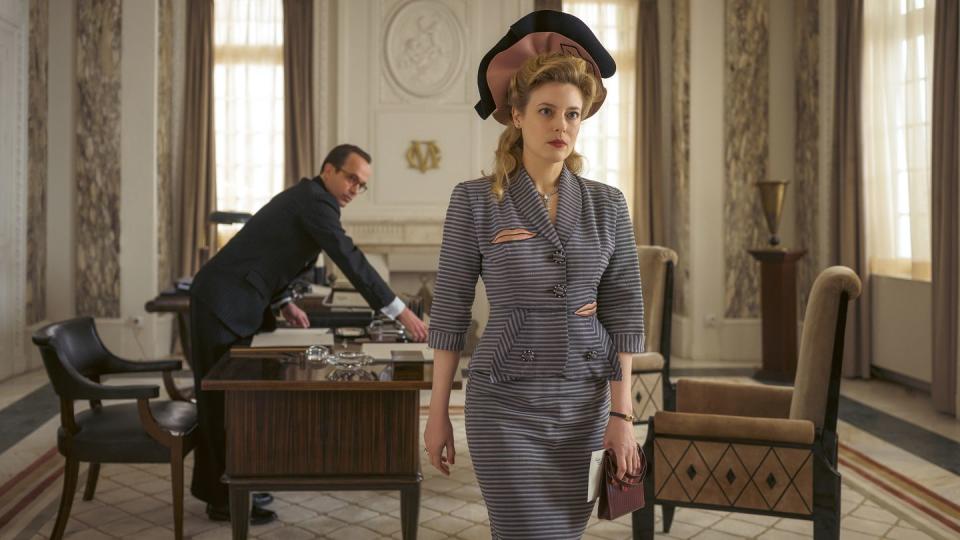The Real Story of Varian Fry, Mary Jayne Gold, and the Netflix Series “Transatlantic”

- Oops!Something went wrong.Please try again later.
- Oops!Something went wrong.Please try again later.
- Oops!Something went wrong.Please try again later.
- Oops!Something went wrong.Please try again later.
"Hearst Magazines and Yahoo may earn commission or revenue on some items through these links."
Often compared to Oskar Schindler, Varian Fry helped over a thousand refugees escape Nazi-occupied France during World War II. Mary Jayne Gold is the heiress who funded and assisted his efforts. Their incredible tale of heroism is the subject of the new television drama Transatlantic, which is now streaming on Netflix.
The seven-episode limited series—which stars Cory Michael Smith as Fry and Gillian Jacobs as Gold—tells the story of the pair’s involvement with the Emergency Rescue Committee, a private American relief group formed in 1940 to rescue European artists, writers, and intellectuals pursued by the Nazis. The ERC’s efforts helped save a number of prominent figures, including artists Marc Chagall and Max Ernst, philosopher Hannah Arendt, and Nobel Prize–winning physiology researcher Otto Meyerhof.
Here’s how the real Fry and Gold got involved in the effort and what happened after they did.
Fry Joins the Emergency Rescue Committee
Even in childhood, Varian Fry was determined to help others. He was born October 15, 1907, in New York City and, by age 9, had organized a fundraiser with his friends for the American Red Cross’ efforts during World War I, according to the Bill of Rights Institute.
But he also had a rebellious streak throughout boarding school and college. Harvard University expelled Fry for several months, according to the University of Pennsylvania’s Literature of the Holocaust archive, but he did eventually graduate with an economics degree in 1931. While at the school, he founded the Hound & Horn literary magazine.
He moved back to New York City after graduation and married Eileen Hughes, an editor at Atlantic Monthly. He worked as a researcher and editor at several magazines in the 1930s, according to the Jewish Virtual Library, and wrote a handful of books about geopolitical relations for the Foreign Policy Association.
However, a 1935 visit to Germany set Fry on the path toward his heroics in World War II. He met with German-American Harvard graduate Ernst Hanfstaengl, who was an official in the German Propaganda Ministry. Hanfstaengl told him that radical Nazi leaders like Adolf Hitler and Joseph Goebbels wanted to exterminate Jews. Fry also witnessed an anti-Semitic riot in Berlin during his trip and wrote several pieces for The New York Times describing what he witnessed.
Fry remembered those scenes in 1940 when he volunteered to be the rescue committee’s representative. “I knew what would happen to the refugees if the Gestapo got hold of them,” he said. “It was my duty to help them.”
Fry’s ERC Role

Paris fell to the invading Germans in June 1940, leading refugees to flood the south of France. According to the United States Holocaust Memorial Museum, this prompted around 200 Americans—including journalists, museum curators, and university presidents—to form the ERC. First Lady Eleanor Roosevelt helped obtain emergency visas for the rescue effort.
Choosing to be the group’s representative, Fry arrived in Marseille on August 5, 1940, with $3,000 in cash strapped to his leg and instructions to help save around 200 refugees, including artists and intellectuals, from the Nazis.
Fry thought he would only stay a month but quickly realized the situation was dire. There were thousands of refugees looking for assistance, and French authorities had refused to issue exit visas. He needed to use deceit and cunning to assist as many as possible. According to Yad Vashem, a Holocaust remembrance center based in Israel, Fry’s team forged documents, smuggled refugees on French troopships, and helped them flee by land.
When word spread that an American could help the refugees, they flooded Fry and his staff with letters—as many as 25 a day—and phone calls. The team conducted over 100 interviews each day, eventually speaking with around 15,000 total. However, limited resources meant Fry had to turn away many who sought assistance. All told, Fry and the ERC helped around 1,500 refugees escape to Spain and provided support to 2,000 more.
Fry’s efforts were admirable, but they drew the ire of French and American authorities. According to the U.S. Holocaust Memorial Museum, French officials constantly monitored Fry and detained him multiple times. Likewise, the United States was not directly involved in the war by this point, but the State Department was concerned his actions would affect relations between the two countries.
The French police arrested Fry on August 29, 1941, and escorted him to the Spanish border. He then returned to the United States in October. The ERC severed ties with Fry in 1942 for his criticism of the State Department.
Mary Jayne Gold’s Assistance

Mary Jayne Gold was an American heiress born in 1909 in the Chicago suburb of Evanston, Illinois. She was the daughter of Margaret and Egbert H. Gold. Her father was an engineer who manufactured radiators and heating systems.
According to the Holland Sentinel, Gold attended finishing school in Italy following the 1928 death of her father. She lived in Paris during the 1930s and, after the German occupation there, eventually moved to Marseille. Gold was also a pilot and owned a private plane, which she donated to the French military.
According to the International Rescue Committee, Gold joined Fry’s staff as an interviewer and courier. She helped expand his original list of 200 refugees and used her fortune to personally fund evacuations. Gold’s money was crucial to Fry and the ERC, as passports and visas could be bought on the black market. She also helped the group rent the Villa Air-Bel property where the staff and some of the refugees resided and conducted work.
Like Fry, Gold was also forced to leave France in 1941 and returned to America.
Fry and Gold After the War
In 1945, Fry published the book Surrender on Demand about his time in France; it was re-released in 1997. He divorced Eileen, who later died in 1948. According to the United States Holocaust Museum, he married Annette Riley one year later; the couple had three children.
But author Sheila Isenberg wrote in her 2001 book A Hero of Our Own: The Story of Varian Fry that Fry “felt unappreciated” and “grew more and more troubled” as time went on. He bounced around multiple jobs, including magazine editing, film production, and college teaching. He developed an ulcer and went into psychoanalysis.
Fry died on September 13, 1967, from a cerebral hemorrhage. In 1996, Yad Vashem honored Fry as a member of the Righteous Among the Nations, or non-Jewish individuals who risked their lives to aid Jews during the Holocaust. The square in front of the U.S. consulate in Marseilles was renamed “Place Varian Fry” in his honor in 2000.
Gold returned to France after the war and settled on the Riviera, according to her New York Times obituary, though she also had a New York City apartment. She published the 1980 book Crossroads Marseilles, 1940 about her experiences with Fry and the ERC.
Gold never married and had no children; she died of pancreatic cancer on October 5, 1997. She is buried at Pilgrim Home Cemetery in Holland, Michigan.
You Might Also Like

